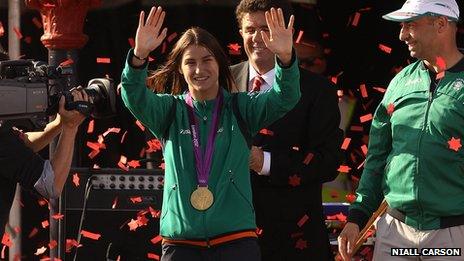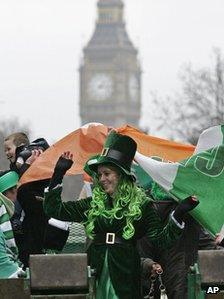Irish immigrants on the decline in England and Wales
- Published

Katie Taylor enjoyed significant support from the London Irish community
With the Celtic Tiger well and truly buried, emigration is once again a looming presence in Irish life.
Towns and villages across the country are losing entire generations. Irish government figures show young people are leaving to seek work mainly in Canada, Australia, New Zealand and the UK.
Anyone who witnessed the huge crowds and exuberant atmosphere at Katie Taylor's fights during the 2012 London Olympics, might feel justified in assuming there are more Irish people in England now than ever.
Eleven years ago, the 2001 census reported that 473,000 residents of England and Wales were born in the Republic of Ireland. At that time, that number made the Irish the biggest immigrant group.
Now, the 2011 census shows that not only have the Irish dropped to fourth place behind Indians, Poles and Pakistanis, but the total number of Irish immigrants has actually decreased to 407,000.
So how have 66,000 apparently gone missing?
Data from the 2011 census released earlier this month shows the overall number of foreign-born residents in England and Wales has risen by nearly 3m since 2001 to 7.5m people.
London, long the favoured destination for Irish immigrants, had both the largest proportion of residents born outside the UK (37%) and non-UK nationals (24%).
Some people who work closely with the London Irish community are surprised at the apparent fall in the numbers of Irish.
Donal Dempsey, who runs an Irish pub in Croydon, said he had seen an increase in Irish customers over the past year or so and the pub had put on more events to cater to the new arrivals.
The London branch of the Gaelic Athletic Association (GAA) has always benefited from a steady supply of immigrants who trained with Gaelic football clubs from an early age in Ireland.
Declan Flanaghan, public relations officer for the London GAA, also finds it difficult to match the census figures with day-to-day reality.
"When I heard those figures mentioned I thought 'something's not right'," he said.
"I've met so many new people who have only arrived here in the last few years."
'First generation'

The 2011 Irish census showed 20,000 people emigrated to the UK
While finding players does not seem to be an issue, some GAA clubs are struggling to find volunteers to help with the administration of clubs. And perhaps this is a clue to the missing 66,000.
Many of the Irish immigrants who first moved to London in the 1950s continued to volunteer their time to help run the clubs after retiring from the pitch.
This generation kept the clubs going for decades, but as they age it is becoming harder to replace them.
The recorded fall in Irish in England and Wales has not surprised Simon McCarthy, welfare manager of the Coventry Irish Centre who also highlights the 1950s wave.
"We go to a lot of funerals. The first generation that came to England in the 1950s are ageing and dying, so that could be the reason," he said.
Bernard Purcell, editor of the Irish World, agrees that the 1950s generation dying off is part of the answer to the missing 66,000, but he also points out that many Irish live with a foot in both England and Ireland.
This mobility of Irish immigrants in England often means they do not end up being counted in the census.
However, Dr Tony Murray, director of the Irish Studies Centre at London Metropolitan University, offers an additional explanation.
"I think the census figures sometimes disguise what is really happening at a specific moment in time," he said.
"This census covers the period until April 2011. Even in the 18 months since then something like 30,000 Irish migrants have come to Britain who are not accounted for".
According to the Republic of Ireland's Central Statistics Office (CSO) 42,000 Irish people left the country in 2011.
The 2011 Irish census showed 20,000 people emigrated from Ireland to the UK, although the statistics available do not distinguish between Irish nationals and foreign nationals.
'Debt and loans'

Jeff Moore is director of welfare at the London Irish Centre
The CSO has projected a further rise in emigration figures for 2012 to 46,500.
One of those recent emigrants is Emer McHugh from County Donegal. She explained why she moved to London.
"The main reason was because there was work," she said.
"Australia and America were too expensive. I've met lots of Irish emigrants over here, especially nurses."
Emer offers another clue to the disappearing Irish - she has no intention of settling in England permanently. Her long term goal is to return home or travel abroad.
Steven Brennan emigrated to Liverpool after graduating and found work in the housing industry.
"I moved to England as there are better opportunities as regards career progression with a better salary. Ireland is quite limited in that respect," he said.
Like Emer and many other Irish, Steven also sees England as a temporary home, ultimately he intends to emigrate to Canada.
"Their economy is stronger. There is a better take home and not as many working hours or stress.
"Taxes and other contributions are too high: full time workers are living off the back of debt and loans.
"This is now considered a way of life."
For Steven, the seeming impossibility of getting onto the property ladder in the UK is another incentive to leave.
"Property prices are too high. I have been working and living here for three years and yet I am in no position to purchase my own home or rent independently," he said.
Jeff Moore director of welfare at the London Irish Centre points out that while the absolute numbers of Irish in England may have declined, they still represent a sizable presence.
"It's really important to note that in London, the community is still the fourth largest single ethnic group.
"London is the main area for settlement for Irish people by a considerable margin and will continue to be so and we know that from historic patterns."
- Published11 December 2012
- Published20 December 2012